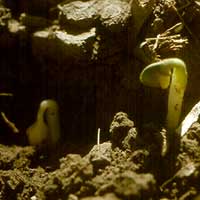
Soil-borne pathogens often infect soybeans in the seedling phase. Photo credit: University of Nebraska.
Treating seeds with fungicides may be beneficial when planting in cold, wet soils, or in reduced till or no-till fields. Additionally, a benefit may be obtained is seed germination is below 80% or a seed lot has low seed vigor. Seed that is mechanically unsound may be damaged further by the treatment process.
Follow label instructions for application rates and additional application instructions. Apply fungicide seed treatments before applying a Rhizobium inoculum and plant seed immediately.
Not all seed treatments are equally effective against the different pathogens that cause seed and seedling diseases. Two general types of seed treatment fungicides are available for control of seedling pathogens. One type is effective against the water-mold pathogens Phytophthora and Pythium, and the other group is most effective against the other fungal pathogens.
For broad-spectrum control of different pathogens, some fungicide products contain a mixture of active ingredients.
Refer to UW Extension publication A3646 Pest Management in Wisconsin Field Crops for specific recommendations.


